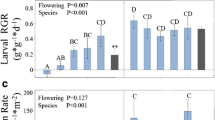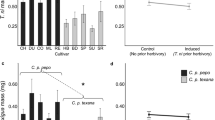Abstract
Constitutive and induced plant resistance against herbivores occurs throughout the plant kingdom, but little is known about the evolutionary relationship between these two types of resistances. We examined the relationships between constitutive and induced resistance to the diamondback moth, Plutella xylostella, in 11 wild species of crucifers, and analyzed the changes in volatiles associated with their expression in two species. We used larvae of P. xylostella and jasmonic acid (JA) as elicitors of the induced response. The level of resistance was estimated as the relative number of eggs laid on the plants by P. xylostella. Substantial variation in constitutive resistance was observed among the 11 crucifer species. When the plants were damaged by larvae, a negative correlation was found between constitutive and induced resistance. However, a positive correlation was detected between constitutive and induced resistance when the plants were treated by JA. The shift in resistance was associated with changes in the emission of volatiles. These results strongly suggest that (1) a trade-off occurs between constitutive and induced resistance in wild crucifers, and that (2) such a trade-off can be observed by treating the plants with a natural, but not an artificial, elicitor.




Similar content being viewed by others
References
Beilstein MA, Al-Shehbaz IA, Kellogg EA (2006) Brassicaceae phylogeny and trichome evolution. Am J Bot 93:607–619
Brody A, Karban R (1992) Lack of a tradeoff between constitutive and induced defenses among varieties of cotton. Oikos 65:301–306
Bruinsma M, Van Dam NM, Van Loon JJA, Dicke M (2007) Jasmonic acid-induced changes in Brassica oleracea affect oviposition preference of two specialist herbivores. J Chem Ecol 33:655–668
Cipollini D, Mbagwu J, Barto K, Hillstrom C, Enright S (2005) Expression of constitutive and inducible chemical defenses in native and invasive populations of Alliaria petiolata. J Chem Ecol 31:1255–1267
Couty A, Van Emden H, Perry JN, Hardie J, Pichett JA, Wadhams LJ (2006) The roles of olfaction and vision in host-plant finding by the diamondback moth, Plutella xylostella. Physiol Entomol 31:134–145
De Vos M, Van Oosten VR, Van Poecke RMP, Van Pelt JA, Pozo MJ, Mueller MJ, Buchala AJ, Métraux JP, Van Loon LC, Dicke M, Pieterse CMJ (2005) Signal signature and transcriptome changes of Arabidopsis during pathogen and insect attack. Mol Plant Microbe In 18:923–937
Dicke M, Hilker M (2003) Induced plant defences: from molecular biology to evolutionary ecology. Basic Appl Ecol 4:3–14
Dicke M, Van Loon JJA (2000) Multitrophic effects of herbivore-induced plant volatiles in an evolutionary context. Entomol Exp Appl 97:237–249
English-Loeb G, Karban R, Walker MA (1998) Genotypic variation in constitutive and induced resistance in grapes against spider mite (Acari: Tetranychidae) herbivores. Environ Entomol 27:297–304
Gardner SN, Agrawal AA (2002) Induced plant defence and the evolution of counter-defences in herbivores. Evol Ecol Res 4:1131–1151
Gianoli E (2002) A phenotypic tradeoff between constitutive defenses and induced responses in wheat seedlings. Écoscience 9:482–488
Halitschke R, Stenberg JA, Kessler D, Kessler A, Baldwin IT (2008) Shared signals—“alarm calls” from plants increase apparency to herbivores and their enemies in nature. Ecol Lett 11:24–34
Heil M, Greiner S, Meimberg H, Krüger R, Noyer JL, Heubl G, Linsenmair KE, Boland M (2004) Evolutionary change from induced to constitutive expression of an indirect plant resistance. Nature 430:205–208
Herms DA, Mattson WJ (1992) The dilemma of plants: to grow or defend. Q Rev Biol 67:283–335
Karban R, Baldwin IT (1997) Induced responses to herbivory. University of Chicago Press, Chicago, IL
Karban R, Myers JH (1989) Induced plant responses to herbivory. Annv Rev Ecol Syst 20:331–348
Karban R, Agrawal AA, Mangel M (1997) The benefits of induced defenses against herbivores. Ecology 78:1351–1355
Keinänen M, Julkunen-Tiitto R, Mutikainen P, Walls M, Ovaska J, Vapaavuorl E (1999) Tradeoffs in phenolic metabolism of silver birch: effects of fertilization, defoliation and genotype. Ecology 80:1970–1986
Koch MA, Haubold B, Mitchell-Olds T (2003) Molecular systematic of the Brassicaceae: Evidence from coding plastidic Matk and nuclear Chs sequences. Am J Bot 88:534–544
Koch MA, Dobes C, Matschinger M, Bleeker W, Vogel J, Kiefer M, Mitchell-Olds T (2005) Evolution of the trnF(GAA) gene in Arabidopsis relatives and the Brassicaceae family: Monophyletic origin and subsequent diversification of a plastidic pseudogene. Mol Biol Evol 22:1032–1043
Koricheva J, Nykanen H, Gianoli E (2004) Meta-analysis of trade-offs among plant antiherbivore defenses: are plant jack-of-all trades, masters of all? Am Nat 163:64–75
Lewinsohn E, Gijzen M, Croteau R (1991) Defense mechanisms of conifers. Differences in constitutive and wound-induced monoterpene biosynthesis among species. Plant Physiol 96:44–49
Litvak ME, Monson RK (1998) Patterns of induced and constitutive monoterpene production in conifer needles in relation to insect herbivory. Oecologia 114:531–540
Liu CL, Ruan Y, Gong CY (2004) β-ocimene as signal molecule elicited expression of defense genes. Chin Sci Bull (Chinese Version) 49:2373–2374
Lu YB, Liu SS (2005) Effects of exogenous jasmonic acid-induced plant responses on development and growth of Plutella xylostella. Chin J Appl Ecol 16:193–195
Lu YB, Liu SS, Liu YQ, Furlong MJ, Zalucki MP (2004) Contrary effects of jasmonate treatment of two closely related plant species on attraction of and oviposition by a specialist herbivore. Ecol Lett 7:337–345
Malcolm SB, Zalucki MP (1996) Milkweed latex and cardenolide induction may resolve the lethal plant defence paradox. Entomol Exp Appl 80:193–196
Morris WF, Traw MB, Bergelson J (2006) On testing for a tradeoff between constitutive and induced resistance. Oikos 112:102–110
Ohsaki N, Sato Y (1994) Food plant choice of Pieris butterflies as a trade-off between parasitoid avoidance and quality of plants. Ecology 75:59–68
Reddy GVP, Tabone E, Smith MT (2004) Mediation of host selection and oviposition behaviour in the diamondback moth Plutella xylostella and its predator Chrysoperla carnea by chemical cues from cole crops. Biol Control 29:270–277
Renwick JAA, Haribal M, Gouinguené S, Städler E (2006) Isothiocyanates stimulating oviposition by the diamondback moth, Plutella xylostella. J Chem Ecol 32:755–766
Shiojiri K, Takabayashi J, Yano S, Takafuji A (2002) Oviposition preference of herbivores are affected by tritrophic interaction webs. Ecol Lett 5:186–192
Sokal RR, Rohlf FJ (eds) (1995) Biometry: the principle and practice of statistics in biological research, 3rd edn. WH Freeman and Company, New York
Strauss SY, Rudgers JA, Lau JA, Irwin RE (2002) Direct and ecological costs of resistance to herbivory. Trends Ecol Evol 17:278–285
Thaler JS, Karban R (1997) A phylogenetic reconstruction of constitutive and induced resistance in Gossypium. Am Nat 149:1139–1146
Thaler JS, Stout MJ, Karban R, Duffey SS (2001) Jasmonate-mediated induced plant resistance affects a community of herbivores. Ecol Entomol 26:312–324
Thaler JS, Farag MA, Paré PW, Dicke M (2002) Jasmonate-deficient plants have reduced direct and indirect defences against herbivores. Ecol Lett 5:764–774
Traw MB (2002) Is induction response negatively correlated with constitutive resistance in black mustard? Evolution 56:2196–2205
Turlings TCJ, Lengwiler UB, Bernasconi ML, Wechsler D (1998) Timing of induced volatile emissions in maize seedlings. Planta 207:146–152
Underwood N (1999) The influence of induced plant resistance on herbivore population dynamics. In: Agrawal AA, Tuzun S, Bent E (eds) Inducible plant defenses against pathogens and herbivores: biochemistry, ecology, and agriculture. American Phytopathological Society Press, St. Paul, MN, pp 211–230
Underwood N (2000) Density dependence in induced plant resistance to herbivore damage: threshold, strength and genetic variation. Oikos 89:295–300
Underwood N, Morris W, Gross K, Lockwood JR III (2000) Induced resistance to Mexican bean beetles in soybean: variation among genotypes and lack of correlation with constitutive resistance. Oecologia 122:83–89
Vet LEM, Dicke M (1992) Ecology of infochemical use by natural enemies in tritrophic context. Ann Rev Entomol 37:141–172
Zangerl AR, Berenbaum MR (1990) Furanocoumarin induction in wild parsnip: genetics and populational variation. Ecology 71:1933–1940
Zhang PJ (2007) Mechanisms of tradeoffs between constitutive and inducible defenses to specialist herbivores in plants. Ph.D. thesis, Zhejiang University, Hangzhou, China
Acknowledgments
We thank Marcel Dicke, Wageningen University, The Netherlands for advice on data analysis and comments on the manuscript. This study was funded by the National Basic Research and Development Program of China (2002CB111403) and the National Natural Science Foundation of China (Project No. 30471146). All experimental procedures comply with the current laws of China.
Author information
Authors and Affiliations
Corresponding author
Additional information
Communicated by Richard Karban.
Electronic supplementary material
Below is the link to the electronic supplementary material.
Rights and permissions
About this article
Cite this article
Zhang, PJ., Shu, JP., Fu, CX. et al. Trade-offs between constitutive and induced resistance in wild crucifers shown by a natural, but not an artificial, elicitor. Oecologia 157, 83–92 (2008). https://doi.org/10.1007/s00442-008-1060-8
Received:
Accepted:
Published:
Issue Date:
DOI: https://doi.org/10.1007/s00442-008-1060-8




